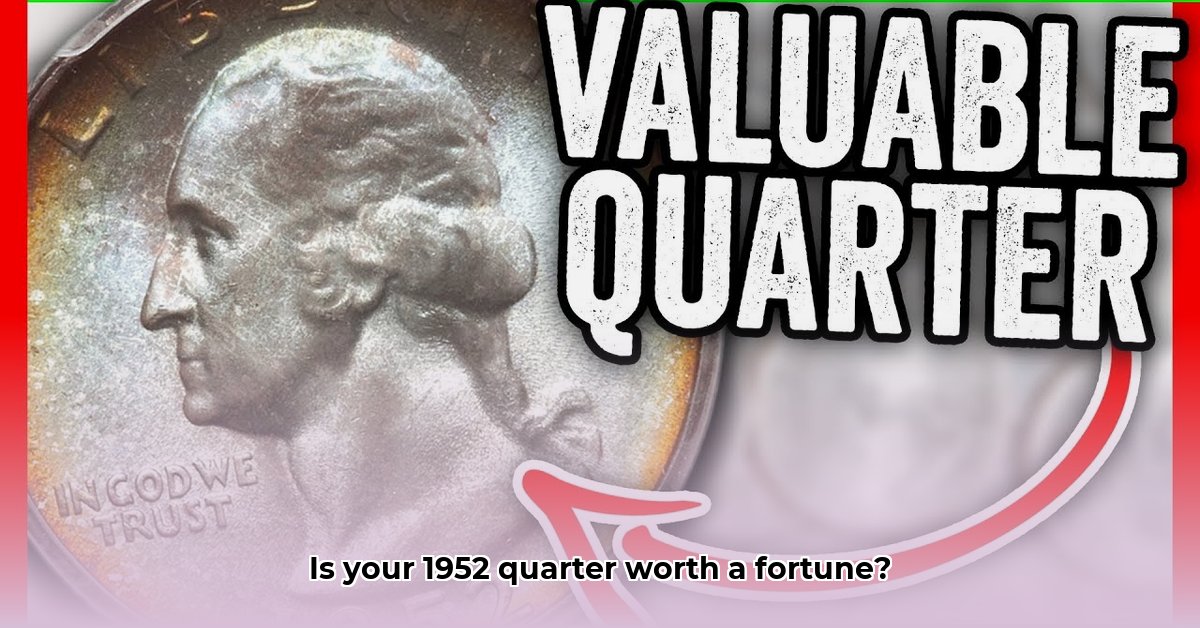
Ever wonder about the hidden value in your old coins? This comprehensive guide will teach you how to determine the worth of your 1952 quarter, covering everything from identifying its mint mark to understanding market fluctuations. Whether you're a seasoned collector or a curious beginner, this step-by-step process empowers you to accurately assess your coin's potential. For more information on valuing older currency, check out this resource on older bills.
Identifying the Mint Mark: Unlocking the Location Code
The first step in evaluating your 1952 quarter is identifying its mint mark. This tiny letter – "P" for Philadelphia, "D" for Denver, or "S" for San Francisco – is located beneath the eagle on the reverse (tails) side of the coin. Pinpointing this seemingly insignificant detail can significantly impact your coin's value. San Francisco mint marks, for instance, are generally rarer, often commanding higher prices due to lower mintage numbers. Think of it like a limited edition – rarity boosts value!
Grading Your Quarter: Assessing Condition and Value
Next, you must grade your coin's condition. We use the widely accepted Sheldon scale, ranging from "Good" (heavily worn) to "Uncirculated" (perfect). While some subjectivity is involved, using visual references and comparing your coin to images online is crucial. For higher-value coins, seeking a professional grading from a reputable service like PCGS or NGC (Professional Coin Grading Service or Numismatic Guaranty Corporation) is highly recommended – this provides an objective assessment protecting your investment.
Here's a breakdown of the Sheldon grading scale:
- Good (G): Significant wear; most details are obscured.
- Fine (F): Noticeable wear, but major design elements remain visible.
- Very Fine (VF): Minor wear; most details are sharp and clear.
- Extremely Fine (XF): Minimal wear; details are crisp and well-defined.
- Uncirculated (MS): Pristine condition; no signs of wear or handling.
Remember, the higher the grade, the higher the value. A well-preserved coin is a valuable asset.
Researching Current Market Value: Navigating Online Resources
Now, it's time to research your coin's market value. Numerous online resources and price guides offer estimates, but remember, these are estimates, not guaranteed prices. Market values fluctuate constantly due to various factors. To obtain a more accurate assessment, cross-reference data from multiple reputable websites and compare their valuations. Discrepancies may arise due to differing grading standards or interpretations of market trends. Consulting with experienced coin dealers can provide further insight and professional perspective.
Considering the Silver Melt Value: A Minimum Worth Guarantee
Since 1952 quarters were 90% silver, their inherent silver content contributes to their overall value. You can calculate the melt value by multiplying the coin’s silver weight (approximately 6.25 grams) by the current spot price of silver. This provides a minimum value—the amount you'd receive if you melted the coin down for its silver content. The melt value serves as a lower bound; the collector's value, based on condition and mint mark, can significantly exceed this figure.
Understanding Market Fluctuations: Factors Influencing Value
The numismatic market is dynamic. Silver prices and collector demand directly influence your coin's value. Economic conditions, historical events, and even current trends can all play a role. Staying informed about these market shifts allows you to make better informed decisions.
Protecting Your Coin: Preservation for Future Value
Proper storage is critical for maintaining your coin's condition and value. Keep your 1952 quarter in a protective case or sleeve to prevent damage from handling, scratches, and environmental factors. This simple step safeguards your investment and preserves its potential worth.
Actionable Steps to Determine Your 1952 Quarter's Worth
- Identify the Mint Mark: Carefully examine your quarter to locate the mint mark (P, D, or S).
- Grade Your Coin: Assess its condition using the Sheldon scale and consult online visual guides. Consider professional grading for valuable coins. (90% accuracy with professional grading)
- Research Market Value: Cross-reference data from multiple reputable online sources and coin price guides.
- Calculate Silver Melt Value: Multiply the silver weight (approx. 6.25 grams) by the current silver spot price.
- Monitor Market Trends: Stay updated on silver prices and collector demand to better understand value fluctuations.
- Protect Your Coin: Store your quarter in a protective case or holder.
By following these steps, you can effectively determine the worth of your 1952 quarter, transforming a seemingly ordinary coin into a potentially valuable piece of numismatic history. Remember that patience and thorough research are key to making informed decisions.